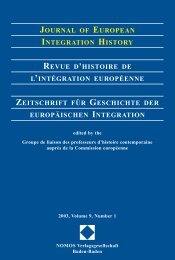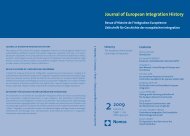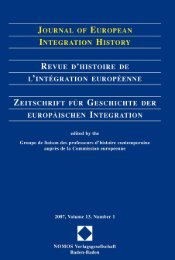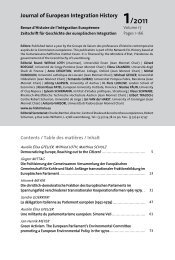journal of european integration history revue d'histoire de l ...
journal of european integration history revue d'histoire de l ...
journal of european integration history revue d'histoire de l ...
You also want an ePaper? Increase the reach of your titles
YUMPU automatically turns print PDFs into web optimized ePapers that Google loves.
Choosing the Periphery 89<br />
mo<strong>de</strong>rnisation plan was to subject sheltered industry to foreign competition and<br />
turn it into an export industry. However, the contract with the tra<strong>de</strong> union movement<br />
and industrial organisations suggested the need for mo<strong>de</strong>rnisation before exposing<br />
the sheltered industry to competition. As <strong>de</strong>veloping the export sector consumed<br />
the majority <strong>of</strong> the investment resources available, mo<strong>de</strong>rnisation lagged<br />
behind. Hence, it was protected throughout the 1950s. Norway was trailing in its<br />
liberalisation <strong>of</strong> import quotas and in the textile industry the government raised tariff<br />
rates when it was forced to liberalise import quotas. For many <strong>of</strong> the commodities<br />
produced by the domestic industry, the tariff rate was between twenty and thirty<br />
percent ad valorem. Prior to the GATT bargaining rounds, negotiators were<br />
always instructed that export interests were to be balanced against the domestic industry's<br />
need for protection. During the Torquay round, in 1951, Norwegian negotiators<br />
would not push the high-tariff countries too hard because “one would risk <strong>de</strong>cisions<br />
which threatened the domestic market industry”. 35 A <strong>de</strong>fensive bargaining<br />
policy for the 1956 Geneva round was <strong>de</strong>veloped because quota liberalisation had<br />
become effective. 36 While Norway was listed as a member <strong>of</strong> the Low Tariff Club<br />
in the OEEC, it was well aware that the tariff rates for domestic industry in a<br />
number <strong>of</strong> cases ma<strong>de</strong> such membership fairly un<strong>de</strong>served. Fears <strong>of</strong> the strong<br />
Swedish industry also encouraged the Norwegian government to reject a Nordic<br />
preference area in the 1950s. As the next section will show, a change in attitu<strong>de</strong>s<br />
concerning domestic industry <strong>de</strong>veloped in 1957-58 and was confirmed by the<br />
EFTA experience. This led, consequently, to regard the Community in the 1960s as<br />
a lesser threat to the Norwegian sheltered industry than heret<strong>of</strong>ore.<br />
The long-term plan <strong>de</strong>veloped in the 1940s also inclu<strong>de</strong>d the primary sector.<br />
Both agriculture and fisheries had low productivity and the goal was to liberate labour<br />
from the primary sector through mo<strong>de</strong>rnisation for the expanding industrial<br />
sector. According to <strong>of</strong>ficial statistics, the outcome <strong>of</strong> this policy was a <strong>de</strong>cline in<br />
the number <strong>of</strong> operator-owned farms from 195,000 in 1949 to 141,000 in 1969.<br />
During the same period <strong>of</strong> time the number <strong>of</strong> fishermen <strong>de</strong>clined from 98,000 to<br />
45,000. At first glance these were dramatic changes. However, the farm units that<br />
disappeared were so small that un<strong>de</strong>r no circumstances would they have provi<strong>de</strong>d a<br />
basis for subsistence. The same trend applied to the fishing fleet. The <strong>de</strong>sire for a<br />
careful mo<strong>de</strong>rnisation in the primary sector allowed both agriculture and fisheries<br />
to retain a structure and an income level that ma<strong>de</strong> them utterly <strong>de</strong>pen<strong>de</strong>nt on protectionism,<br />
market regulations and State subsidies. Thus, the prospect <strong>of</strong> Norway's<br />
Community membership was perceived from the primary sector as a real threat.<br />
Due to the operating structure <strong>of</strong> the sector, the drop in employment was not translated<br />
into a proportionate drop in electoral strength. In 1949 full-time farmers operated<br />
only about forty per cent <strong>of</strong> the farms. In 1969 the proportion dropped to thirty-three<br />
35. RA, Privatarkiv Norges Industriforbund [Private archive <strong>of</strong> the Norwegian Industrial Association]<br />
(henceforth, PNI), box 1746, Report from the Norwegian <strong>de</strong>legation at the international tariff negotiations<br />
in Torquay, undated.<br />
36. UD 44.2/13, Report from the committee set up to prepare Norwegian policy at the tariff negotiations<br />
in Geneva, undated.

















